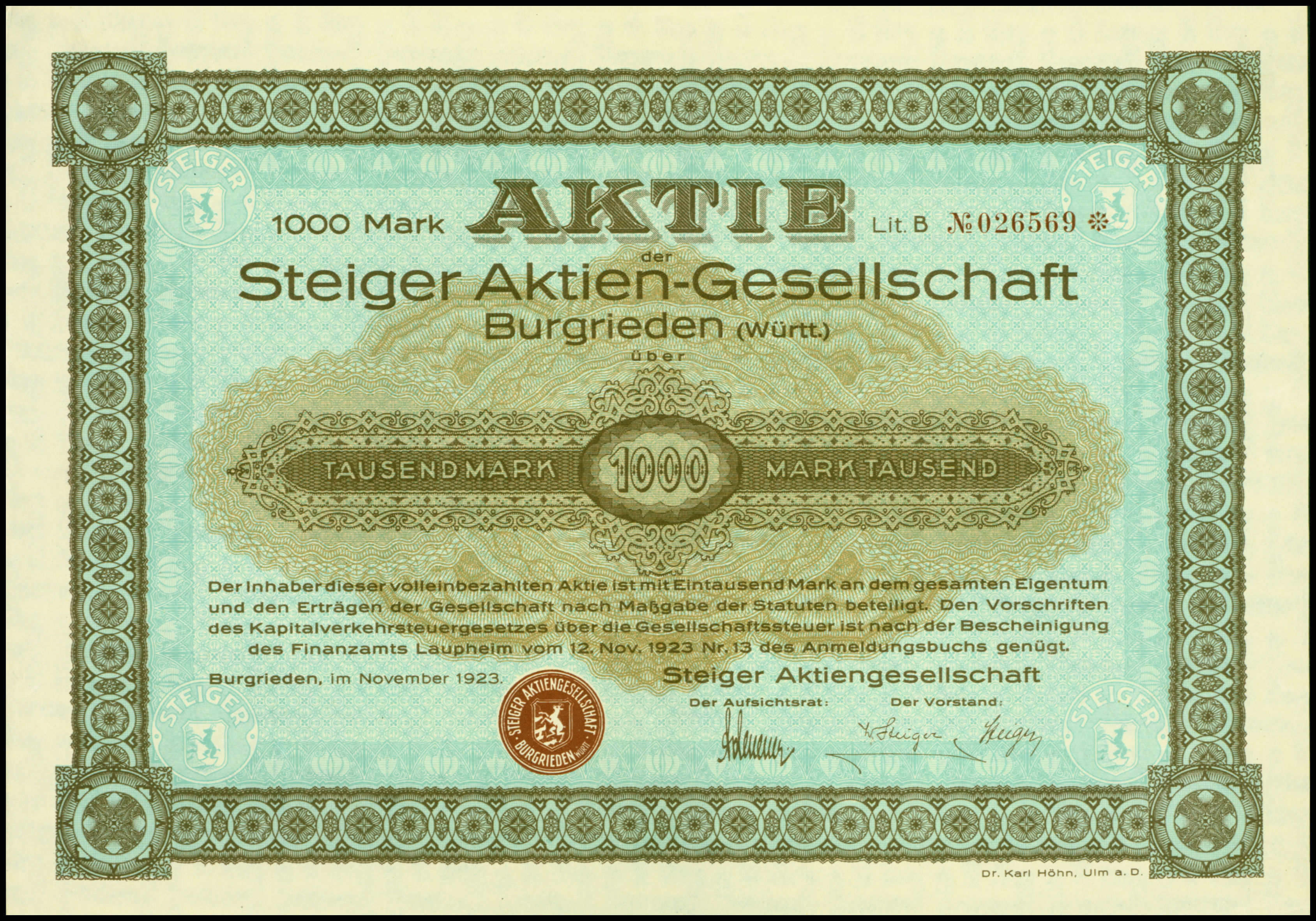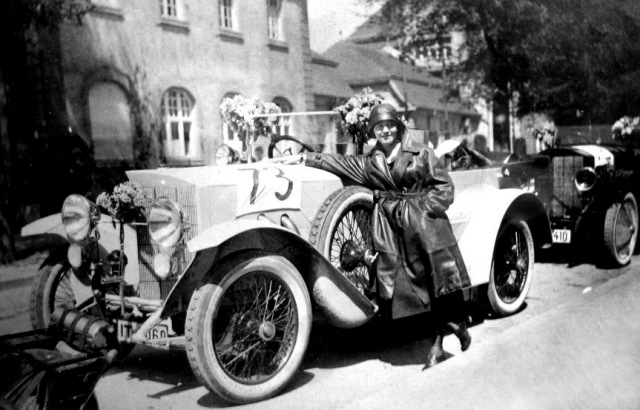Steiger (automobile company) on:
[Wikipedia]
[Google]
[Amazon]
 The Steiger company was founded in 1914 as Maschinenfabrik (engine manufactory) Walther Steiger & Co. by the Swiss engineer Walther Steiger (1881–1943) in Burgrieden near Ulm, Germany. In 1921 it became a
The Steiger company was founded in 1914 as Maschinenfabrik (engine manufactory) Walther Steiger & Co. by the Swiss engineer Walther Steiger (1881–1943) in Burgrieden near Ulm, Germany. In 1921 it became a 
 During
During
 In 1922 Steiger produced a two-seated roadster with a larger engine (cubic capacity 2.8 litres, 55 hp / 40 kW) that became available in 1924 as an even more powerful model (cubic capacity 2.9 litres, 70 hp / 51 kW). These types reached a maximum speed of 140 km/h (88 mph) (100 hp racing models could reach a speed of 180 km/h (113 mph)) and cost 18,000 Reichsmarks. Those high-performance sports and racing models were very successful at racing events (
In 1922 Steiger produced a two-seated roadster with a larger engine (cubic capacity 2.8 litres, 55 hp / 40 kW) that became available in 1924 as an even more powerful model (cubic capacity 2.9 litres, 70 hp / 51 kW). These types reached a maximum speed of 140 km/h (88 mph) (100 hp racing models could reach a speed of 180 km/h (113 mph)) and cost 18,000 Reichsmarks. Those high-performance sports and racing models were very successful at racing events (
 After the liquidation of his firm, Walther Steiger joined the Swiss automobile manufacturer Martini where he and his brother Robert had been the major shareholders since 1924. They produced a number of vehicles for Martini, including a 95 hp (70 kW) six-cylinder model. This luxury vehicle with a 4.4-litre engine appeared in Switzerland as Martini-Six and in Germany as 17/100 PS Steiger-Martini.Jung, pp. 86 ff.
Following the pattern at Steiger, a number of different racing models were developed, and some achieved spectacular successes (twice reaching the first four in the 1929 Klausenpass race, for example). However, these carefully and individually manufactured models could not compete in the long run with cheaper, mass-produced vehicles from Germany, France and America. The end of a brand steeped in tradition was inevitable: on 12 June 1934 the last Martini left the factory in Saint-Blaise on Lake Neuchâtel.
After the liquidation of his firm, Walther Steiger joined the Swiss automobile manufacturer Martini where he and his brother Robert had been the major shareholders since 1924. They produced a number of vehicles for Martini, including a 95 hp (70 kW) six-cylinder model. This luxury vehicle with a 4.4-litre engine appeared in Switzerland as Martini-Six and in Germany as 17/100 PS Steiger-Martini.Jung, pp. 86 ff.
Following the pattern at Steiger, a number of different racing models were developed, and some achieved spectacular successes (twice reaching the first four in the 1929 Klausenpass race, for example). However, these carefully and individually manufactured models could not compete in the long run with cheaper, mass-produced vehicles from Germany, France and America. The end of a brand steeped in tradition was inevitable: on 12 June 1934 the last Martini left the factory in Saint-Blaise on Lake Neuchâtel.

Image:Steiger_automobile_10.jpg, The last one: Steiger 11/55 PS
Image:Steiger_automobile_11.jpg , Steiger engineer Walter Kaufmann on Steiger racing car, type Targa-Florio (1924)
Image:Steiger_automobile_16.jpg , Eye catcher – Steiger 10/50 PS
Steiger-burgrieden
€”{{in lang, de
Vintage vehicles Defunct motor vehicle manufacturers of Germany Vehicle manufacturing companies established in 1914 Vehicle manufacturing companies disestablished in 1926 1926 disestablishments in Germany German companies established in 1914
 The Steiger company was founded in 1914 as Maschinenfabrik (engine manufactory) Walther Steiger & Co. by the Swiss engineer Walther Steiger (1881–1943) in Burgrieden near Ulm, Germany. In 1921 it became a
The Steiger company was founded in 1914 as Maschinenfabrik (engine manufactory) Walther Steiger & Co. by the Swiss engineer Walther Steiger (1881–1943) in Burgrieden near Ulm, Germany. In 1921 it became a limited company
In a limited company, the liability of members or subscribers of the company is limited to what they have invested or guaranteed to the company. Limited companies may be limited by Share (finance), shares or by guarantee. In a company limited by ...
(Steiger AG). During its short life the firm produced circa 3,000 vehicles.

Founding and Early History
World War I
World War I (28 July 1914 11 November 1918), often abbreviated as WWI, was one of the deadliest global conflicts in history. Belligerents included much of Europe, the Russian Empire, the United States, and the Ottoman Empire, with fightin ...
the Steiger firm repaired aeroplanes
An airplane or aeroplane (informally plane) is a fixed-wing aircraft that is propelled forward by thrust from a jet engine, propeller, or rocket engine. Airplanes come in a variety of sizes, shapes, and wing configurations. The broad spectr ...
and aeroplane engines. In 1917 the owner and his engineer, Paul Henze, began to work on motorized vehicles. Plans for the manufacture of tractors were abandoned in favour of automobiles; their first model, the Steiger 10/50 PS, was produced in 1920. This touring model with a 2.6-litre four cylinder engine (50 hp / 37 kW) became Steiger's most significant product and was still in production when the firm collapsed in 1926. Its modern OHC
An overhead camshaft (OHC) engine is a piston engine where the camshaft is located in the cylinder head above the combustion chamber. This contrasts with earlier overhead valve engines (OHV), where the camshaft is located below the combustion cha ...
engine was distinctive because of an overhead camshaft
A camshaft is a shaft that contains a row of pointed cams, in order to convert rotational motion to reciprocating motion. Camshafts are used in piston engines (to operate the intake and exhaust valves), mechanically controlled ignition systems ...
driven by spiral-toothed bevel gear wheels. These cars, with 'u' shaped pressed steel frames, two axles with leaf spring suspension, and a pointed radiator, were considered to be "the most significant technical innovation of the early 1920s" and "the most progressive German serially-produced cars of their time".
A brief flowering
 In 1922 Steiger produced a two-seated roadster with a larger engine (cubic capacity 2.8 litres, 55 hp / 40 kW) that became available in 1924 as an even more powerful model (cubic capacity 2.9 litres, 70 hp / 51 kW). These types reached a maximum speed of 140 km/h (88 mph) (100 hp racing models could reach a speed of 180 km/h (113 mph)) and cost 18,000 Reichsmarks. Those high-performance sports and racing models were very successful at racing events (
In 1922 Steiger produced a two-seated roadster with a larger engine (cubic capacity 2.8 litres, 55 hp / 40 kW) that became available in 1924 as an even more powerful model (cubic capacity 2.9 litres, 70 hp / 51 kW). These types reached a maximum speed of 140 km/h (88 mph) (100 hp racing models could reach a speed of 180 km/h (113 mph)) and cost 18,000 Reichsmarks. Those high-performance sports and racing models were very successful at racing events (Solituderennen
The ''Solituderennen'' (eng: ''Solitude race'') motorsport events are held on the 11.4 km ''Solitudering'' race track near Stuttgart. The event and the track were named after the nearby Castle Solitude. Motorsports events were held there from ...
, Avus, Eifelrennen
The Eifelrennen was an annual motor race, organised by ADAC Automobile Club from 1922 to 2003, held in Germany's Eifel mountain region even before the NĂĽrburgring was built there.
History
Starting from 1922, the first races were held on a 33 ...
, Klausenrennen, Monza
Monza (, ; lmo, label=Lombard language, Lombard, Monça, locally ; lat, Modoetia) is a city and ''comune'' on the River Lambro, a tributary of the Po River, Po in the Lombardy region of Italy, about north-northeast of Milan. It is the capit ...
and Targa Florio) in the 1920s. The more powerful touring car, the Steiger 11/55 PS, arrived in 1925 with an extended wheelbase
In both road and rail vehicles, the wheelbase is the horizontal distance between the centers of the front and rear wheels. For road vehicles with more than two axles (e.g. some trucks), the wheelbase is the distance between the steering (front ...
and the first sports car's engine.
At its peak the firm occupied up to 500 workers and employees. Despite their high-class products that were often compared with those of Bugatti
Automobiles Ettore Bugatti was a German then French manufacturer of high-performance automobiles. The company was founded in 1909 in the then-German city of Molsheim, Alsace, by the Italian-born industrial designer Ettore Bugatti. The cars w ...
, the firm went bankrupt in the wake of the 1926 automobile crisis.
Steiger-Martini
 After the liquidation of his firm, Walther Steiger joined the Swiss automobile manufacturer Martini where he and his brother Robert had been the major shareholders since 1924. They produced a number of vehicles for Martini, including a 95 hp (70 kW) six-cylinder model. This luxury vehicle with a 4.4-litre engine appeared in Switzerland as Martini-Six and in Germany as 17/100 PS Steiger-Martini.Jung, pp. 86 ff.
Following the pattern at Steiger, a number of different racing models were developed, and some achieved spectacular successes (twice reaching the first four in the 1929 Klausenpass race, for example). However, these carefully and individually manufactured models could not compete in the long run with cheaper, mass-produced vehicles from Germany, France and America. The end of a brand steeped in tradition was inevitable: on 12 June 1934 the last Martini left the factory in Saint-Blaise on Lake Neuchâtel.
After the liquidation of his firm, Walther Steiger joined the Swiss automobile manufacturer Martini where he and his brother Robert had been the major shareholders since 1924. They produced a number of vehicles for Martini, including a 95 hp (70 kW) six-cylinder model. This luxury vehicle with a 4.4-litre engine appeared in Switzerland as Martini-Six and in Germany as 17/100 PS Steiger-Martini.Jung, pp. 86 ff.
Following the pattern at Steiger, a number of different racing models were developed, and some achieved spectacular successes (twice reaching the first four in the 1929 Klausenpass race, for example). However, these carefully and individually manufactured models could not compete in the long run with cheaper, mass-produced vehicles from Germany, France and America. The end of a brand steeped in tradition was inevitable: on 12 June 1934 the last Martini left the factory in Saint-Blaise on Lake Neuchâtel.
Steiger models

See also
* Martini (automobile company) – Saint-Blaise, Switzerland * auto motor und sport-TV: "Die faszinierendsten Autos der Welt – Klassiker", DVD (2002), EAN 4-260000-950484, Youtube: yy-3BHWqXkI * ARD "Rasthaus" 1999 (German TV) "Der fast vergessene Steiger", Youtube: 4dEkE5hlXekPictures
Sources
* Hans-Heinrich v. Fersen (1): ''Autos in Deutschland 1920–1939''. Stuttgart 1964. * Hans-Heinrich v. Fersen, a.o. (2): ''Klassische Wagen 1919–1939''. Cologne 1994, * Ferdinand Hediger: ''Oldtimer – Interessante Automobile von 1885–1939''. Berne 1982, * Helmut and Uta Jung: ''Stuttgarter Karosseriewerk Reutter''. Bielefeld 2006, * Ralf J.F. Kieselbach and Hans-Erhard Lessing: ''Faszination der Form – Automobildesign in Baden-Württemberg''. Stuttgart, Weimar 2002, * Werner Oswald: ''Deutsche Autos 1920–1945''. Stuttgart 1982, * Michael Schick: ''Steiger – Die Geschichte einer schwäbischen Autofabrik in den 20er Jahren''. Laupheim 1999,References
External links
Steiger-burgrieden
€”{{in lang, de
Vintage vehicles Defunct motor vehicle manufacturers of Germany Vehicle manufacturing companies established in 1914 Vehicle manufacturing companies disestablished in 1926 1926 disestablishments in Germany German companies established in 1914